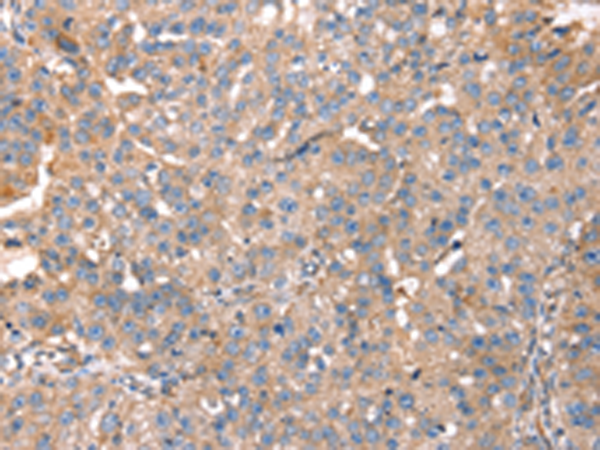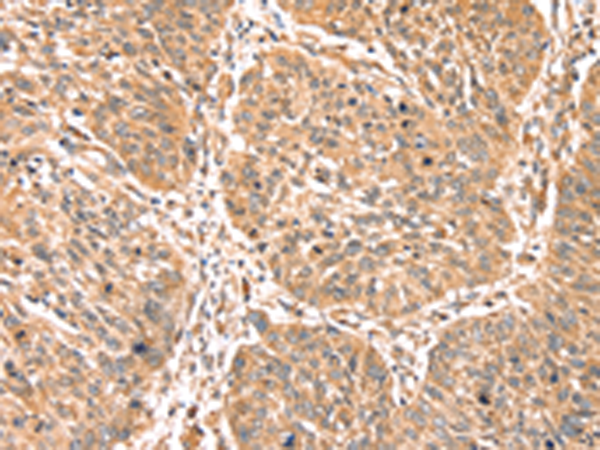


| WB | 1/500-1/2000 | Human,Mouse,Rat |
| IF | 咨询技术 | Human,Mouse,Rat |
| IHC | 1/25-1/100 | Human,Mouse,Rat |
| ICC | 技术咨询 | Human,Mouse,Rat |
| FCM | 咨询技术 | Human,Mouse,Rat |
| Elisa | 1/2000-1/5000 | Human,Mouse,Rat |
| Aliases | RIL |
| WB Predicted band size | 35 kDa |
| Host/Isotype | Rabbit IgG |
| Antibody Type | Primary antibody |
| Storage | Store at 4°C short term. Aliquot and store at -20°C long term. Avoid freeze/thaw cycles. |
| Species Reactivity | Human, Mouse, Rat |
| Immunogen | Fusion protein of human PDLIM4 |
| Formulation | Purified antibody in PBS with 0.05% sodium azide and 50% glycerol. |
+ +
以下是关于PDLIM4抗体的参考文献示例(注:以下内容为示例,实际文献需通过学术数据库查询):
---
1. **文献名称**: "PDLIM4 as a prognostic biomarker in prostate cancer: immunohistochemical analysis"
**作者**: Smith J, et al.
**摘要**: 本研究通过免疫组化(IHC)分析了PDLIM4在前列腺癌组织中的表达,发现PDLIM4蛋白表达水平降低与肿瘤转移和不良预后显著相关。研究验证了一种商业化PDLIM4抗体的特异性,并支持其作为临床检测工具的潜力。
2. **文献名称**: "Development and validation of a monoclonal antibody for PDLIM4 in cellular models"
**作者**: Zhang Y, et al.
**摘要**: 文章报道了一种新型抗人PDLIM4单克隆抗体的开发,通过Western blot和免疫荧光技术验证了其在多种癌细胞系中的特异性。该抗体成功用于研究PDLIM4在细胞核与细胞质中的定位差异。
3. **文献名称**: "PDLIM4 expression correlates with cardiac remodeling in murine models"
**作者**: Lee H, et al.
**摘要**: 研究利用PDLIM4抗体在小鼠心脏组织中进行免疫染色,发现PDLIM4在心肌肥厚模型中表达上调,提示其可能参与心脏重构的分子调控机制。
4. **文献名称**: "PDLIM4 as a tumor suppressor: Insights from antibody-based silencing assays"
**作者**: Wang X, et al.
**摘要**: 通过siRNA和特异性抗体阻断实验,研究证实PDLIM4通过抑制NF-κB通路发挥肿瘤抑制作用。抗体在流式细胞术中的成功应用为后续功能研究提供了工具支持。
---
**建议**:实际研究中,可通过PubMed、Google Scholar等平台以“PDLIM4 antibody”、“PDLIM4 immunohistochemistry”等关键词检索最新文献,并关注抗体货号(如Abcam、Santa Cruz等厂商)以获取技术细节。
The PDLIM4 antibody is designed to detect the protein PDLIM4 (PDZ and LIM Domain 4), a member of the PDZ-LIM protein family characterized by its conserved PDZ (Postsynaptic Density-95/Discs Large/Zonula Occludens-1) and LIM (Lin-11. Isl-1. Mec-3) domains. PDLIM4. also known as RIL or CLP36. functions as a cytoskeletal adaptor protein involved in organizing actin filaments and mediating intracellular signaling pathways. It plays roles in cell adhesion, migration, and differentiation by interacting with components like α-actinin, receptor tyrosine kinases, and transcription factors.
PDLIM4 is expressed in various tissues, including the heart, skeletal muscle, prostate, and neurons, and has been implicated in multiple physiological and pathological processes. Studies highlight its dual roles in cancer—acting as a tumor suppressor in some contexts (e.g., inhibiting cell proliferation in prostate cancer) or promoting metastasis in others (e.g., enhancing invasiveness in breast cancer). Dysregulation of PDLIM4 is also linked to cardiovascular diseases and neurological disorders.
The PDLIM4 antibody is widely used in research to investigate its expression patterns, subcellular localization, and molecular interactions via techniques like Western blotting, immunohistochemistry, and immunofluorescence. Its specificity and reliability make it a critical tool for exploring PDLIM4’s functional mechanisms and its potential as a therapeutic target or diagnostic biomarker, particularly in oncology and neurology.
×